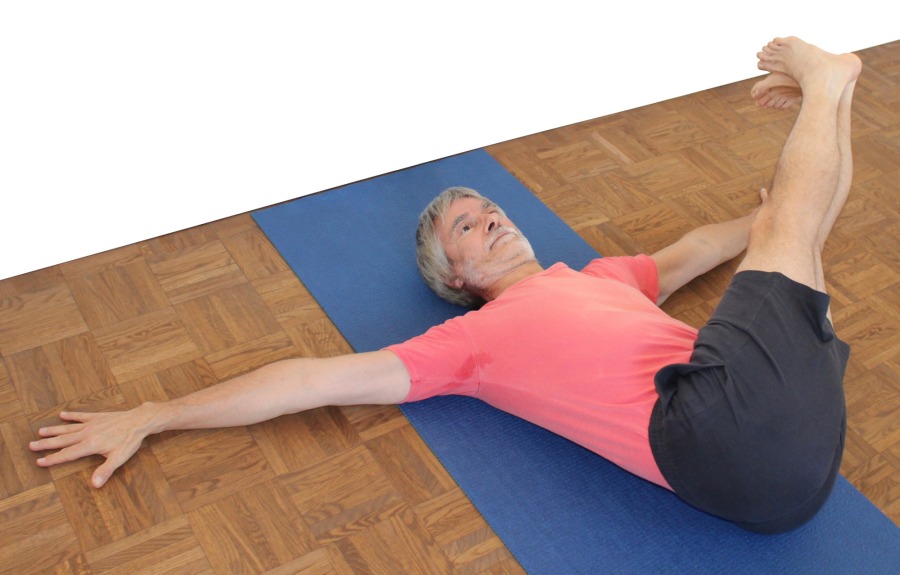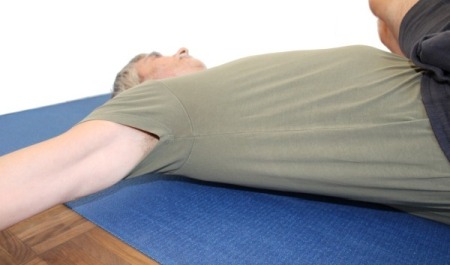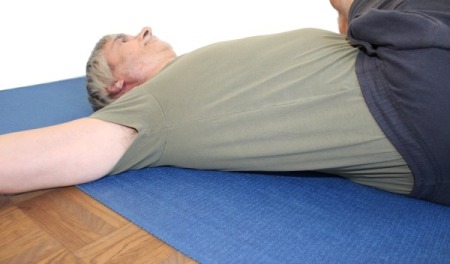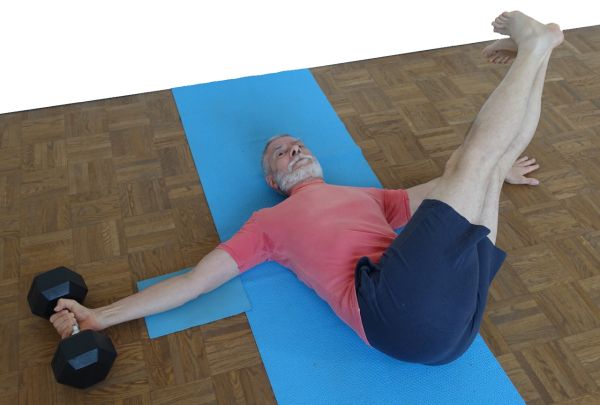yogabook / asanas / jathara parivartanasana
jathara parivartanasana
„which twists the stomach „

 instructions and details with working links as PDF for download/print
instructions and details with working links as PDF for download/print
Tue und lasse
shoulder lifts | shoulder on the floor |
Detail images
starting position |
Feedback: We would love to hear what you think about this description, give us feedback at:
postmeister@yogabook.org
last update: 30.12.2018
Name: jathara parivartanasana
Trivial name: the one that twists the stomach
Level: A
- Classification: A
- contraindication
- Effects of
- Preparation
- follow-up
- derived asanas
- similar asanas
- diagnostics
- Instruction
- details
- Variants
Classification
classic: lying pose
physiological: strengthens the oblique abdominal muscles and the triceps
Contraindication
Pregnancy: the oblique abdominal muscles exert pressure on the abdominal cavity due to their tension. Herniated disc also often react badly to rotation of the spine and are therefore a contraindication.
Effects
- (212) Neck: rotation strength
- (247) Strengthening the retrovertors of the shoulder joint
- (292) Strengthening the trapezius
- (302) Strengthening the triceps
- (307) Strengthening the biarticular middle triceps
- (662) Strengthening the rotatory muscles of the trunk
- (677) Strengthening the oblique abdominal muscles obliqui abdomini
- (741) Strengthening the abductors
- (226) Shoulder blade: stretching for retraction
- (211) Neck: rotation stretch
when the head is turned contralaterally - (601) Stretch for rotation of the spine
Preparation
An important prerequisite for this pose is flexibility in the hamstrings so that the legs can be moved far enough towards the upper body and do not remain so far away that a hollow back develops. Practise this:
- uttanasana as a generally effective and efficient stretch of the hamstrings to prepare for flexion in the hip joints in this pose
- prasarita padottanasana very similar to uttanasana
- parsvottanasana
- pascimottanasana
- janu sirsasana
- tryangamukhaikapada pascimottanasana
- downface dog as another good preparation for the hamstrings when the pelvis is tilted powerfully
- hip opener 5 as a very effective stretch of the hamstrings that goes beyond uttanasana
- warrior 3 pose
- trikonasana
- parivrtta trikonasana as a particularly synergistic pose
- parivrtta ardha chandrasana
If not only the hamstrings but also the glutes hinder the flexion (and slight adduction of the upper leg), practise:
- half lotus forward bend
- hip opener at the edge of the mat
- hip opener 3
- parivrtta trikonasana
- parivrtta ardha chandrasana
- parivrtta parsvakonasana
The ability to rotate the spine and torso is also very important:
- sitting twist as a very effective and efficient exercise for twisting
- parivrtta trikonasana
- parivrtta ardha chandrasana
- maricyasana 1
- maricyasana 3
- parivrtta parsvakonasana
Strength for retroversion of the arm is also required. There are not many poses for this, especially those that strengthen the entire triceps, not just the relevant caput longum, for example:
- the variation „with feet upside down“ of downface dog
- Pressing your hands to the floor in a headstand also strengthens the triceps
- the three-point variation of headstand, which also strengthens the triceps
- bhujangasana
- staff pose
Follow-up
Triceps: If there was a tendency to cramp in the triceps, practise:
- upper half of gomukhasana with the arm that has cramped as the upper arm.
Derived asanas:
Similar asanas:
Diagnostics (No.)
Various disorders can be found in forward bending movements (flexion in one/both hip joints), but also under (here: lower) load in the muscles of the back of the leg:
- Shortening of the hamstrings, see FAQ.
- Damage to the hamstrings that causes pain or functional limitations can also be easily recognised here, from simple tension to strains to muscle (partial or complete) tears. Tears may lead to increased flexibility compared to the other side.
- Irritation of the sciatic nerve, which innervates the leg and foot, can become symptomatic, especially when bending forwards, even if they are otherwise rather calm. See the FAQ.
- Irritation of the origin of the hamstrings at the ischial tuberosity (also known as PHT: Proximal Hamstring Tendinopathy) can occur in this pose, but only if they are pronounced, as the flexion moment in the hip joint is rather small. They require protection from intensive stretching, see the FAQ.
- Baker’s cysts create a feeling of tension or a foreign body in the back of the knee, see FAQ.
Pain may indicate existing hip damage, e.g:
- Arthrotic change (degenerative with cartilage atrophy) of the joint
- Arthritis (joint inflammation) of various kinds
- Perthes‘ disease in children and hip dysplasia in general can react to this pose
- Dislocation / subluxation, which would cause a significantly increased sensation of tension in various muscles covering the hip joint
- Joint trauma suffered, which may cause pain in the joint even after many weeks or months
The triceps is a very interesting muscle in this posture, through the retroversion of its medial biarticular portion it is instrumental in keeping the contralateral shoulder down and all the heads (including the two monoarticular ones) extend through the elbow joint. An inability to keep the elbow joint extended indicates a lack of strength in the triceps; spasm tendency and spasm in the biarticular middle head may indicate increased tone and also a lack of strength.
(676)(677) The oblique abdominal muscles (obliqui externi abdomini and obliqui interni abdomini):
The rotation of the upper body through the large lever represented by the two legs is a very powerful movement. On the one hand, the oblique abdominal muscles allow this movement according to their flexibility; on the other hand, they also hold the weight of the pelvis with the legs. Some have to work hard at the limit of their extensibility in long sarcomere length, some at the limit of their contractibility in short sarcomere length. A lack of strength in these muscles does not allow the pelvis and legs to be held in a wide rotation (legs far towards the ground), because according to the angle functions, the gravity induces load increases as the angle to the ground decreases (the gravitational effect of the the legs would be equal to 100% in a horizontal position according to the sine of 90° to the direction of gravity). On the other hand, their flexibility (together with the capability to adduct at 90° flexion in the hip joint of the upper leg) restricts the angle between the pelvis and the floor.
(670) Abdomen:
Since the oblique abdominal muscles exert a clear pressure on the abdominal cavity, we may obtain indications of conditions or events in the organs of the abdominal cavity through the disturbances of well-being that occur here.
Variants:
(S) Pressing the shoulder down
Instructions
- Lie in savasana.
- Stretch the arms out to 90° to the spine and pronate the forearms with the hands so that the palms are facing the floor (pronation) and press the palms forcefully onto the floor.
- Raise your legs until they are vertical.
- Turn the legs so that the feet are pointing towards the right hand.
- Pressing both hands forcefully onto the floor, continue to extend your arms, especially the right arm.
- Slowly move the legs further and further to the bottom right and slightly towards the head until the toes are hovering about 30 cm above the right hand.
- To change sides, first bring the legs back to the starting point in a vertical position without turning the legs, before turning them in the other direction and lowering them to the hands.
Details
- To change sides, turn the feet in the direction of the other hand, which is an internal rotation in the hip joint of the upper leg and an external rotation in the hip joint of the lower leg.
- Keep the tips of your toes as close to 30 cm above your hand as possible, both a lower position (resting on the greater trochanter of the lateral thigh of the lower leg) and a higher position (the gravitational effect of the leg depends on the angle to the floor) is a simplification. The 30 cm rule is only a rough approximation that ensures that support on the greater trochanter cannot occur; depending on the individual anatomy, it is usually possible to fall below 30 cm without this already being the case. If, as is not uncommon, there is a lack of strength in the arms to support the body in order to prevent the body from tipping sideways, or a lack of strength in the oblique abdominal muscles to hold the pelvis with the legs, only move the legs down to the hand to that extent that they can be held there. Similar to the staff pose, the rule „only take the pose to the extent that you can leave it the way you took it and do not force yourself to give up (there: lie down on the floor)!
- It is highly recommended to bring the tips of your toes over your hands and not to keep your legs further away from your head, i.e. to flex your hips less, as otherwise you are very likely to fall into a hollow back, which should be avoided due to the large lever of the legs. In cases where the flexibility of the hamstrings is not sufficient for this, it is better to bend the knee joints so far that the feet can hover over the hands. If the flexibility of the hamstrings is good, the legs are straight and the feet are as in tadasana. Particularly if the legs are well extended and the legs are moving strongly towards the head against not very flexible hamstrings, there may be a tendency to cramp in the rectus femoris, which must of course be avoided. Slight bending of the knees should provide immediate relief. A tendency to cramp in the abduction apparatus of the upper hip joint is also not uncommon. The abductor tensor fasciae latae, which holds the leg against sinking into further adduction, flexes the hip joint and supports knee extension, comes into question here.
- Keep the arms fully extended at the elbow joints throughout the exercise with sufficient triceps strength so that the elbows do not touch the floor. The further the legs move towards the hand, the smaller the tilting moment and the greater the force that tries to bend the elbow joint, i.e. the bending moment and therefore also the force required from the triceps to keep them stretched. Do not bend the elbow joint and prevent the elbow from touching the floor. The upper arm is maximally turned out so that the inner elbow points upwards. If the appropriate force is applied, the middle biarticular part of the triceps in particular can be perceived as working powerfully, possibly with a cramp-like note, as a retroversion movement is performed in the shoulder with the elbow extended and the middle biarticular head of the triceps is at a quite short sarcomere length and therefore close to active insufficiency. Keeping the elbox extended may not be possible at first if the muscles are not very strong. Since the shoulder joint of the side to which the legs move is on the ground and remains so after the pose is constructed, the elbow joint is very close to the ground anyway, and only a few cm or mm are missing for the elbow to touch down. This detail requires all the more attention. If it is not clear whether the elbows are touching the floor, the hand on the same side can be placed on a thin elevation.
- Hold the arms sideways at 90° to the spine to maximise the lever arm for support.
- The entire pelvis will naturally rotate slightly to one side (onto the iliac crest), depending primarily on the available adduction of the upper leg in the hip joint and the flexibility (rotational ability) of the trunk. If the pressure of the iliac crest on the floor is uncomfortable, use a blanket as a support.
- Keep the arms maximally turned out in the shoulder joints, until further notice. Following the anatomical inclination, the outer hand would have more weight than the inner hand. Press your palms firmly on the floor and pronate your forearm as much as possible so that the palm and outer hand have approximately the same weight. Depending on your flexibility, the maximum external rotation of the upper arms in the shoulder joints runs counter to the requirement to press the palm of the hand onto the floor, as the available pronation of the forearm is not sufficient with good external rotation in the shoulder joint. In this case, decide in favour of pressing the palm of the hand to the floor, but try to extend the external rotation of the arm further. Maximum external rotation of the upper arm is important for two reasons based on an anatomical fact: only in this state is the axis of rotation of the elbow joint approximately horizontal, so bending the elbow joint moves the elbow more or less vertically towards the floor or extending it vertically away from it. This results in the most favourable situation in terms of strengthening the triceps. On the other hand, only in this position is the elbow joint loaded purely physiologically, without varus stress or valgus stress.
- The contralateral shoulder (the shoulder opposite the hand to which the leg is moving) should remain on the floor. This requires some strength in the retroversion or transversal abduction resp. of the supporting arm in the shoulder joint as well as in the triceps in order to keep the elbow joint extended. If the trunk’s ability to rotate is significantly restricted, the position of the foot 30 cm above the hand (in relation to the tips of the toes) may not be compatible with the shoulder being held down. In this case, the position 30 cm above the hand is the more important detail, as with every degree that the leg is moved less downwards, the effect of gravity and not least the torques in the spinal segments, glenohumeral joint and elbow joint and thus the effectiveness of the pose decreases.
- There are several options for the head: to control the position of the legs and feet, it is advisable to turn it to the same side; from a perspective of movement physiology, it is of course more interesting to turn it to the opposite side, which corresponds, for example, to parivrtta trikonasana with the head facing upwards.
- Moving the legs a little towards the head must not cause the pelvis to lift off the floor to a large extent, even with the iliac crest at the bottom, and the lumbar spine to become convex (kyphosis).
Variants
Hold on to a dumbbell

Instructions
- Take the pose as described above.
- Using the strength of the arm flexors, press the elbow to the floor just before lifting the barbell.
Details
on elbows
Instructions
- Assume the position as described above, but instead of pressing your palms onto the floor, press your bent elbows onto the floor.
Details
- If the pressure of your elbows on the floor is uncomfortably hard, use a soft pad such as a patch or blanket under your elbows.
- This variation is usually easy to perform if the standard variation is painful due to golfer’s elbow or tennis elbow.
(P) Press shoulder down

Prevent the opposite shoulder from lifting off the floor.
Instructions
- Take the pose as described above.
- The supporter presses the shoulder of the opposite side to which the legs are moving onto the floor.
Details
- The supporter simultaneously controls the position of the legs and ensures that the performer does not fall into a hollow back.
- If both hands are pressed together for the support and these are pressed vertically from above at shoulder height (the acromion), the type of pressure is usually comfortable. In contrast, if the pressure is applied too much on the outside (laterally), it often leads to a tearing sensation in the performer’s skin on which the pressure is applied.
